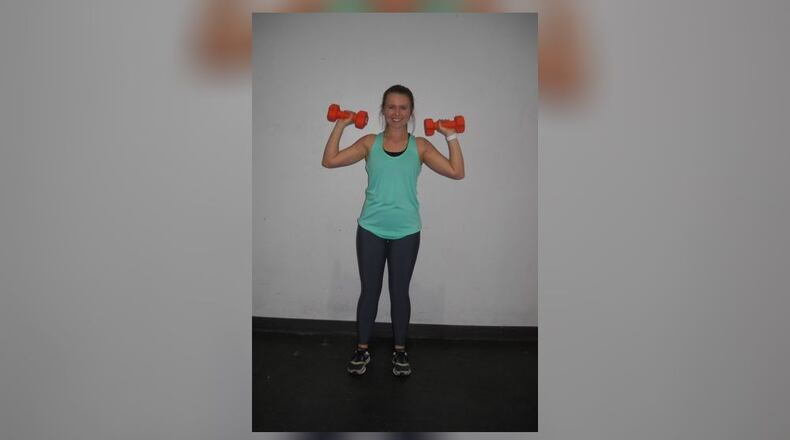Hold a dumbbell in each hand at shoulder height with palms facing forward (photo 1). Looking straight head, slowly push arms overhead (photo 2) until extended, without locking out the elbow joint. During the downward phase, lower the dumbbells in a slow, controlled manner.
Tips
Avoid over flexing or extending the wrists, and do not allow dumbbells to drift forward as you are pushing or lowering. Instead, you should see the weights in your peripheral vision throughout each repetition
The spinal column should remain in proper alignment, without excessive arching or rounding. There is no need to shrug or pull the shoulder blades back excessively, instead, try to maintain normal posture.
Avoid using heavy weights. Pushing too much weight overhead can easily interfere with proper form and increases risk of injury to the shoulder joint and spine. Muscles need appropriate time under tension during both phases of a repetition. If weights are too heavy, reliance on excessive momentum rather than muscle power will be necessary, detracting from potential benefit.
Variations
For those who find it difficult to complete the Shoulder Press with elbows out the sides, the exercise can be performed with the palms facing in. In this case, the elbows would be kept closer to the body and dumbbells pushed upward until arms are nearly fully extended.
The Shoulder Press can be performed either standing or seated. If standing, a strong midsection is needed in order to stabilize the spine. If the abdominals are unable to contract isometrically to hold the spine in place, you will notice the hips moving forward as the low back over-arches, increasing risk of injury.
For those who wish to work on improving balance, using a stability ball can be a good option. You can use dumbbells, a barbell, resistance bands, or kettlebells. Most gyms have a variety of machines available to work the shoulder muscles for those who aren’t comfortable using free weights.
If unaccustomed to this exercise, consider using a spotter until you are familiar with proper form. Start with 1 to 2 sets of 8 to 12 repetitions with a weight that slightly fatigues the muscles. Take time to gently stretch between each set. As you get stronger, you can increase sets, reps or amount of resistance used.
Remember that not all exercises are right for everyone. If you have joint problems or medical conditions, check with your doctor before beginning an exercise program.
Marjie Gilliam is an International Sports Sciences Master certified personal trainer and fitness consultant. She owns Custom Fitness Personal Training Services LLC. Send email to marjie@ohtrainer.com.
Credit: Contributed
Credit: Contributed
About the Author


